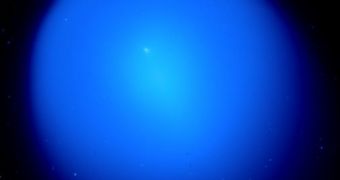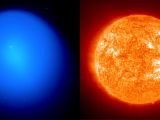The Sun used to be considered the biggest object in the solar system. Though not as massive and compact as the star, comet Holmes currently has a volume larger than that of the Sun. The second outburst in history took place on the 24th of October this year, when the comet expanded and multiplied its brightness about one million times that of the normal one, making it observable with the naked eye on the night sky.
Expanding at a rate of about 0,5 km per second ever since, the cloud of gas emerging from its coma now measures 1,4 million kilometers in diameter, a measurement taken on the 9th of November by Rachel Stevenson of the University of Hawaii, making it the largest single object in the solar system.
The eruption is produced by ejecting dust, water vapor and traces of ethane and acetylene, from the core of the comet, measuring only 3,6 kilometers in diameter, comprised of a solid nucleus made of ice and rock. The observations were taken using the only professional instrument still capable of photographing the whole comet in a single image, the wide-field camera on the Canada-France-Hawaii Telescope of CFHT. The comet has enhanced its brightness for half a million times since the first outburst on 24th of October.
Also the images show that comet Holmes is developing a tail, a characteristic which was not previously available, due to the solar wind pressure acting on the dust grains emerging from its coma. It is expected in the next months that the tail and the coma will expand even more and then fade away as it travels away from the Sun and the dust disperses.
The same behavior has been observed in the year the comet was first discovered, presenting a double outburst, first in November 1892 and the second in January 1893. For now it is not known whether the comet will behave exactly in the same way as in 1892 or not, but astronomers have predicted that a second outburst might take place and they are ready to observe it. Most of the observed comets which visit our solar system generally show very small fluctuations in brightness and some have distinct outbursts, but an outburst at the scale of that of comet Holmes is unprecedented.
Comet Holmes is part of the class of Jupiter Family Comets, meaning they are strongly influenced by Jupiter's powerful gravity and has a period orbit of 6 years. Astronomers think that this kind of objects have had an orbit around the Sun which takes them beyond the orbit of Neptune, in a region of the solar system called the Kuiper Belt.
As the comet orbits the Sun it loses mass through evaporation from the heat of the Sun slowly dying by running out of gas and during the next thousands of years, its orbit will probably intersect that of the Sun or a planet or will be ejected out of the solar system.

 14 DAY TRIAL //
14 DAY TRIAL // 
